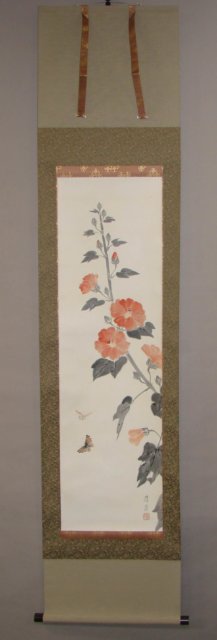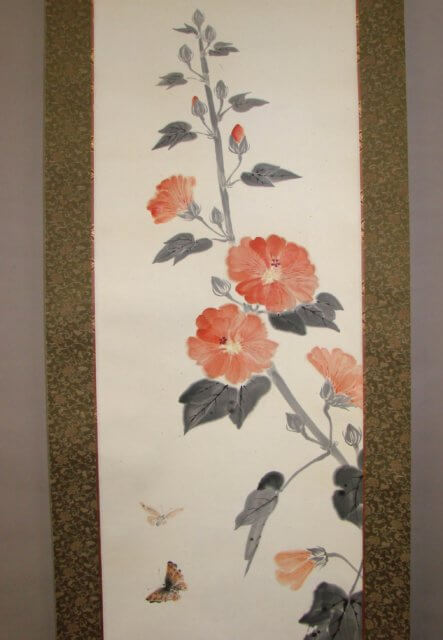Remounting Framed Artwork Painted on Japanese Paper in Kakejiku / the US
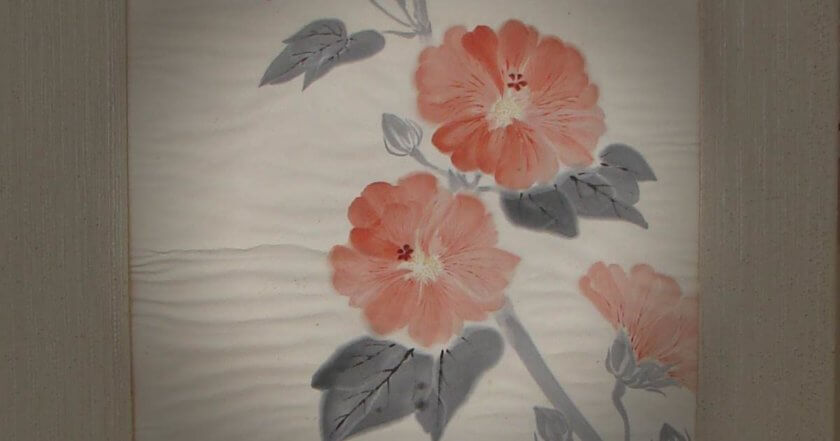
Remounting a Framed Artwork Painted on a Japanese Paper in a Kakejiku / the United States
One of the frequent questions received from our customer is
‘Can you remount my framed artwork in a kakejiku?’
In short, it all depends.
Whether we can perform the task or not depends on a type of the material, paint, and ink used for the work.
As for the material, since a kakejiku is opened to display and rolled up for its restoration, a certain degree of flexibility and strength are required in order that these repetitive actions will be achievable.
When material of an artwork is thin Japanese paper or silk, we can carry on the remount work. In contrast, a remounted kakejiku using a thick or hard material will cause breaks when it’s rolled up like a hard drawing paper makes a break after being rolled with a small diameter.
Regarding the paint and ink, since a great deal of water is used for remounting a framed artwork, those of which don’t contain glue will be blurred or ran. It may be easy if you imagine words or something written by a marker will become blurry when watered.
Here are the points to be noted regarding mounting a work.
The topic this time is a remounting request of a framed artwork by a male customer all the way from California, the United States.
Contents
A Request of Remounting a Framed Artwork in a Kakejiku from the United States
The requested artwork.
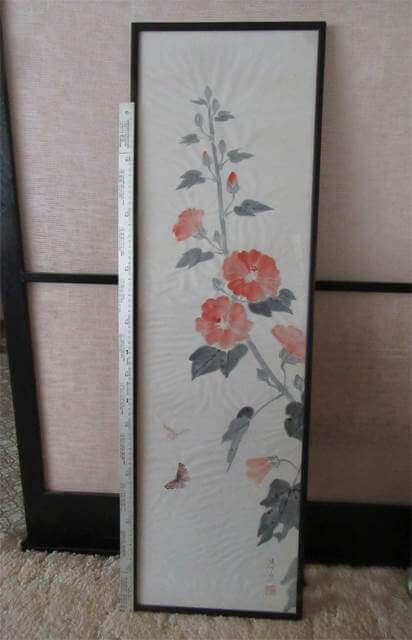
An artwork portraying a red hollyhock. The flower which represents early summer starts to bloom around the rainy season in Japan. For the details of seasonal kakejiku, please visit the link here.
I was explained that the framed artwork wasn’t pasted to the frame and that means the work itself can be removed from the casing and sent.
An artwork attached to its frame is meant to be sent being enclosed in the frame as it’s torn when stripped off the underframe forcefully for that reason, a substantial shipping charge for the delivery, this time, from the U.S. to Japan will occur. I was glad that this particular concern was cleared.
Given that the material the art was painted is allegedly a Japanese paper, I could go for the remounting still, I shouldn’t feel at ease until I check the actual artwork. – As the picture didn’t show the texture and thickness of the paper and actually, the type of Japanese paper is quite diversified.
Well, the material more or less got through, so the next hitch is a kind of the paint.
I was surprised by him saying it is ‘watercolors’.
This material which spreads and runs when it is watered is basically the absolute no-no for mounting.
Although special agents for blur prevention could help, it doesn’t guarantee the positive result 100% so we must gain customers’ acceptance of the possible risk in advance.
But the customer claiming it was ‘watercolors’ admitted that he wasn’t really sure about the fact answering, ‘I just guessed it might be.’ without any positive proof.
Since I had a doubt speculating ‘In case the paints were watercolors, as the step uses water the painting must’ve been blurred when it had its backing process done, which it actually did, given it’s been framed, but the piece appeared to have any sighs of the ruin so probably it isn’t watercolors.’, I conveyed this speculation to the customer then received his acceptance before he shipped his artwork.
Previous Arrangement
The artwork has arrived in one piece from the U.S.
Even though it has had a backing work done, the paper was rather thin therefore, I assumed that we could transform it into a kakejiku after removing its old backing paper.
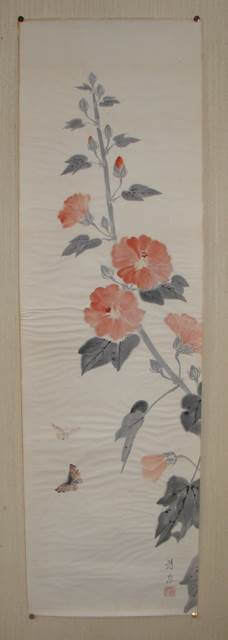
As for the issue of the material of the paint, it didn’t look like watercolors, even so the glue seemed like weakening.
A painted part is checked prior to proceeding with a mounting work by softly touching there with a lightly dampened cotton bud or cotton wool and red paint was rubbed off with this case.
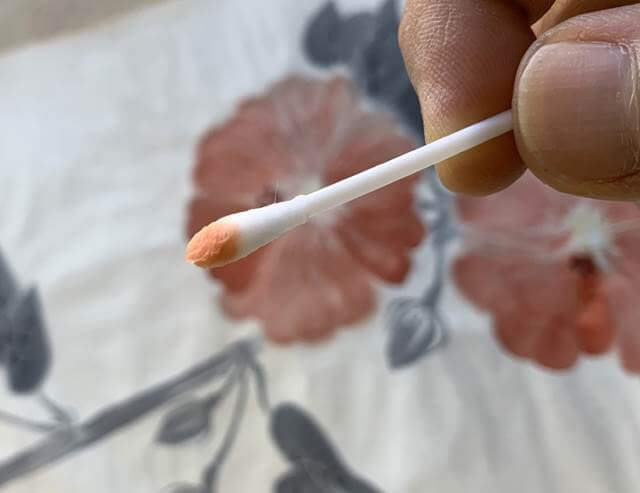
I assessed that a regular fixing agent wouldn’t work but still an agent with the next stronger level will stop the spread as the paint wasn’t watercolor.
Having said that, because the work was supposed to be proceeded by our mutual agreement, before undertaking it, I again ensured the customer that we couldn’t perfectly guarantee that there will be any risk. – The confirmation is really essential.
Then we made a previous arrangement for the remounting.
The customer selected his favorite from the several result images we had created for him in advance.
A style of the remounting he chose is shown in the following picture.

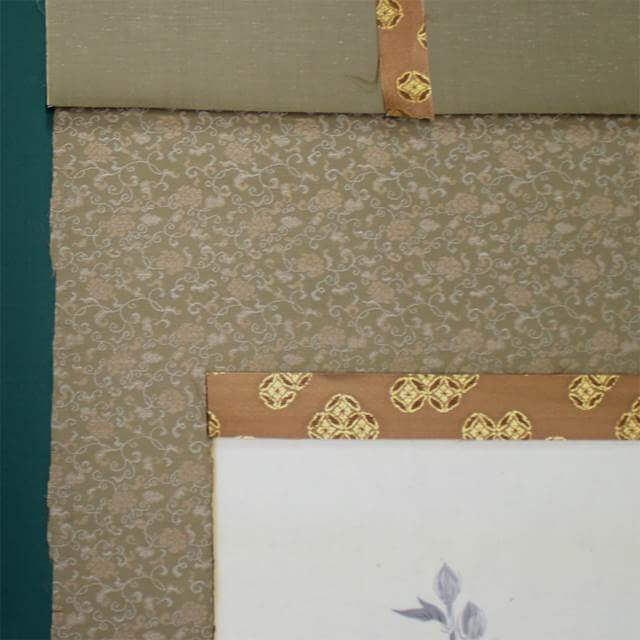
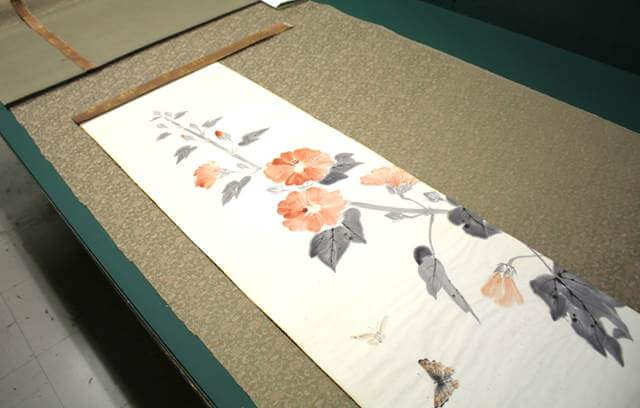
The mounting fabric whose color and pattern bring out the vague red color of hollyhock was selected.
At last, it’s time to start off the work, after the advance arrangement the payment was also confirmed.
Process of Remounting a Framed Artwork into a Kakejiku
The summarized step by step process of the work is as follows.
Iro Dome / color fixing – A multiple application of a strong fixing agent.
↓
Old Backing Paper Removal – Peeling off the old backing paper on the reverse of the artwork.
↓
Remounting –Transforming the piece into a kakejiku with the fabric of the customer’s choice.
Completion of The Remounting, Transforming a Framed Artwork into a Kakejiku
The remounting work is at last brought to completion after going through the lengthy process.

In fact, the worrisome color blurring hasn’t occurred and the remounting was a success. It superbly made me feel content.
I’m very glad to see the color and pattern of the fabric used for this mounting enhancing color of the hollyhock which all went according to plan.
I sent the finished piece to the customer promptly.
The customer seemed so pleased with the newly made kakejiku that he sent us his message below. I rejoiced over his comment.
I received the kakejiku today.
You did a very beautiful job.
Thank you.
We feel proud that our expertise was once again, utilized for a demand of a customer globally.
We take a remounting request which makes over your framed artwork into a kakejiku internationally.
Please feel free to contact us if you have any inquiries concerning this particular remounting.



